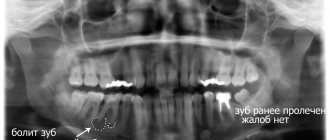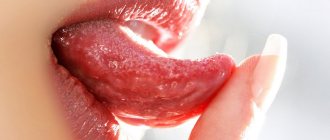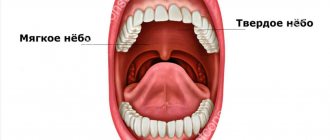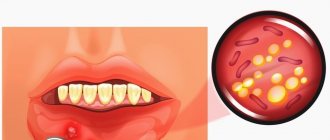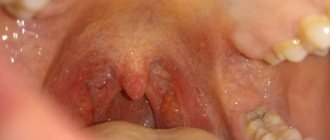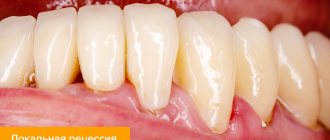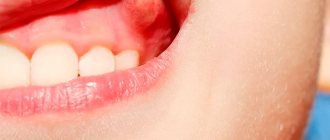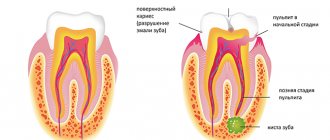Mucosal injuries in children are not uncommon. But if redness of the conjunctiva or a dried drop of blood in the nasal passages immediately attracts attention, then scratches on the palate of a child may remain unnoticed until they are complemented by other symptoms.
What can cause such damage and how to help a child in such situations?
Scratches on the palate of a child - how and how to treat them?
by Vlad · Published 06/05/2018 · Updated 05/07/2019
Mucosal injuries in children are not uncommon. But if redness of the conjunctiva or a dried drop of blood in the nasal passages immediately attracts attention, then scratches on the palate of a child may remain unnoticed until they are complemented by other symptoms.
What can cause such damage and how to help a child in such situations?
Causes and associated symptoms
In the vast majority of cases, a scratch on the palate of a child is the result of careless handling of cutlery, consumption of hard and dry foods (crackers, biscuits, chips, etc.), as well as the use of stationery, household items, toys, etc. for other purposes.
Most often, children in the first 3-5 years of life are susceptible to injuries, who are still unable to understand and remember the basics of safety precautions, and unintentionally cause harm to themselves.
But if the periodic appearance of scratches that heal quickly can be explained by accidental damage to the mucous membrane of the palate, then the following circumstances should be taken more carefully:
- Multiple small scratches. This may be a sign of stomatitis - what appears to be small abrasions upon examination is actually inflammatory damage. As a rule, the palate is not the only affected area, and the same or similar lesions can be found on the mucous membrane of the cheeks, the surface of the tongue, under the tongue, etc.
- Scratches that take a long time to heal. When a wound forms, it looks like an ordinary abrasion, but within a few days, instead of healing, it becomes loose, and its edges become red and swollen. Such a symptom may indicate disturbances in the microflora of the oral cavity, as a result of which there is a fading of local immunity and a decrease in the regenerative abilities of tissues. The same symptom is characteristic of vitamin deficiency, but with vitamin deficiency, delayed healing of any wounds is observed not only on the mucous membranes, but also on the skin.
How to distinguish a star from a planet?
A planet can be distinguished from a star by the nature of its radiation: the stars twinkle, but the planet does not
.
Indeed, this is not a bad way to distinguish a planet from a star. But if there is great excitement in the earth’s atmosphere, for example a hurricane, then the planets may begin to flicker. Our Sun is also a star. But it is much closer to Earth than the stars we see at night. The sun is not a point in the sky. We perceive the Sun as a large, uniformly shining disk. If the Sun were trillions of kilometers away from the Earth, it would be lost among many other stars and would twinkle just like them. The twinkling of a star is very beautiful and can inspire a poet.
But for an astronomer this is truly a headache. Even if the sky is very clear, large movements of air masses occur in the atmosphere, so-called disturbances, which make observing and photographing stars very difficult.
Even Jupiter's atmosphere is very poor in neon, apparently for this reason. The red neon emission line is also responsible for the red light emitted by helium-neon lasers. It is commercially extracted by fractional air distillation. It is significantly more expensive than helium, since its only source is air. Neon is typically found in the form of a monatomic gas, making it lighter than the nitrogen and diatomic oxygen molecules that make up most of the Earth's atmosphere. A neon filled balloon rises into the air, although more slowly than a helium balloon.
The best time for astronomical observations is clear nights and a calm, undisturbed atmosphere. When the atmosphere above the telescope is calm, astronomers observe with good visibility and almost no flickering. With the development of the space age, powerful telescopes were launched into orbit, through which scientists observe the true picture of cosmic silence and examine the stars shining with a calm, eternal light.
Neon is a noble gas and is not known to form bonds. Therefore, it is generally considered inert, but a fluorine compound can be prepared in the laboratory. There are no true neutral neon compounds. Scottish chemist William Ramsay, along with Morris Travers, made the first discovery of neon gas in a year in which the gas occurs naturally in the atmosphere, but in smaller quantities.
The first tube was known as the Geissler tube. This tube was made for scientific purposes only. Scientists used this tube to study the electrical discharges of various substances. George Claude was the first to make a neon lamp. He combined electrical gases and passed a small amount of electric current through them and voila! made in different colors. He then realized that a glass tube containing neon gas could be twisted into different positions. He made a lamp to show at the Paris Exhibition, which was held that year. Packard Motors loved Claude's idea and immediately signed a contract for thousands of dollars.
Even without being an astronomer, you can easily distinguish stars from planets in the night sky. The planets shine with an even light and from the Earth look like tiny circles with smooth edges.
Stars do not give such a glow - they seem to flicker and shimmer, and can take on different shades. Why is this happening?
When to see a doctor?
Usually, a scratch on the hard palate does not pose a danger if the wound is treated in a timely manner and appropriate measures are taken to speed up its healing.
But sometimes you may need the help of a doctor:
- If abrasions or wounds on the palate appeared as a result of a fall or blow that damaged the teeth. Small fragments of teeth or fragments of enamel may remain in the mucosa, which will interfere with healing and provoke a long-term inflammatory process. In addition, the teeth themselves need immediate treatment, so you need to contact your dentist as soon as possible.
- The area of the scratch increases or the number of scratches increases. This symptom may indicate an active inflammatory process, which can only be stopped with medications selected by a specialist.
- The child has other symptoms indicating a possible somatic infection or spread of pathogens from the oral cavity to the oro- and nasopharynx (fever, lethargy and drowsiness, complaints of headache and aches throughout the body, etc.)
The listed circumstances require the attention of a specialist - only a doctor will be able to determine the source of the problem and prescribe the treatment necessary in a specific clinical case.
Treatment methods
Treatment of any damage in the oral cavity begins with antiseptic treatment of wound surfaces. For this, a solution of Chlorhexidine, Corsodil, Furacilin, Fucorcin and other drugs is used. If there are signs of a bacterial infection, the doctor prescribes antimicrobial agents in the form of gels, ointments, sprays (Metrogil Denta, Miramistin, Tantum Verde, etc.), which are applied to scratches or to the entire surface of the mucous membrane according to the instructions.
Impaired regenerative abilities of the mucous membrane due to dysbiosis requires the use of local prebiotics (Ayufalak, Lactulose, etc.), and drugs that improve immunity and promote healing (Imudon, Lykopid, Solcoseryl, etc.). All drugs should be prescribed only by a doctor and only after a personal examination - drugs that are highly effective in one case will be completely useless in another, and will only delay the recovery time.
First aid
A cut on the palate of a child should be treated immediately and properly to reduce the likelihood of infection. To do this, treat the scratch or abrasion with an antiseptic solution appropriate for the child’s age.
If you don’t find anything suitable in your home medicine cabinet, you can prepare a decoction of chamomile, a strong solution of green tea, which should be alternated with a solution of soda (1/2 cup of warm water per ½ teaspoon of soda) - one rinse of the mouth with decoction or tea, the second - soda solution.
You should also exclude from the child’s menu any dishes or products that irritate the wound (pickles, hot foods, dry cookies, sour fruits or vegetables, etc.).
These measures are especially important if the cut or scratch on the palate is located close to the pharynx, and also if the child has an increased tendency to infectious diseases or has recently suffered an illness or surgery, and his immunity is weakened.
Starlight and the Earth's Atmosphere
Stellar twinkling visible to the human eye is not a property of stars, but a feature of visual perception from Earth. You've probably noticed that the twinkling of stars is especially colorful on frosty nights or immediately after rain?
How do neon lights and signs work?
This was the beginning of neon signs.
Neon can be pumped into a sealed tube as an inert gas. It will begin to float freely inside. When an electric current passes through a pipe containing neon, it uses kinetic energy. The current stimulates the atoms present in the neon molecules. The electrons are then released into the gas. The ions and electrons are scattered throughout the neon, which transfers charge from one end of the tube to the other, thus igniting the entire tube. The tubes used contain different colors and therefore the light emitted is colored. The fact is that the reason for the twinkling of stars is the atmosphere. Stars emit light, which on its way to the Earth passes through layers of the atmosphere, and it is known to be heterogeneous.
Starlight rays need to penetrate areas of the atmosphere with different densities and temperatures, and this directly affects the refraction of light rays. Sections of gas layers of different densities make this refraction multidirectional.
We should not forget that air masses are moving: warm currents rise upward, cold currents descend to the surface of the Earth. Depending on its temperature, air refracts light differently. When a star's light moves from a high-density layer of the atmosphere to a lower-density layer and vice versa, it becomes flickering. The brightness of the stars itself also changes: they dim, then shine again.
You didn't have to learn much about the sky to find the cardinal points, because what was taught was simply a way of identifying them. Aren't you curious to know how it happens if the recipe always works? The other day it was written that every day of the year the sun rises and goes to different positions. So the recipe works any day of the year?
The answer to this question is: yes, it works any day of the year or more, it works anywhere on the planet that you experience. Of course, if you're at one of the Earth's poles, the day can last six months, so it's hard to pick a time before noon, but it works.
Scientists call this process scintillation. In addition, the process of light emission from stars is influenced by turbulent vortices that move in different directions at different altitudes.
Different parts of the atmosphere act on a beam of light, like lenses with constantly changing curvature. The rays, passing through these peculiar “lenses,” are either scattered or concentrated again. This is also accompanied by color scattering, so stars located low above the horizon can change their hue.
However, the movements of stars in the sky serve not only to determine the main points. By observing closely, we can learn much more. Let's now see what we can observe from the sky and what movements the stars make. During the day we see several stars. Using only our eyes, we can see the Sun, the Moon and very difficult the planet Venus - commonly known as Estrela d'Alva.
We have already seen that the most important is the Sun. Observing and following its movement through the rod could be determined at cardinal points. We also learn about days and nights, the phases of the moon, and how the seasons occur by observing the sun during the day.
The higher you are from the Earth, the less noticeable the stellar twinkling is - the layer of the atmosphere becomes thinner, the optical effect on the light rays decreases. It is for this reason that scientific observatories are usually built as high as possible in the mountains - from there it is easier to observe the stars without being distracted by strong twinkling.
There is no atmosphere in space, and, according to astronauts and available images from space telescopes, the stars there shine with an even and calm light.
Watch the sky for a few minutes at night so you can see the stars clearly, preferably in a small area away from city lights. First notice the variety of stars that exist, some very bright, others almost faded. Note that stars come in different colors, the simplest being blue and orange. Looking closely, you will find some that look like well-faded cotton candy. An example you should try to find is the Orion Nebula.
This is very close to the "Three Marys" which are very visible between the months of November and April. In November, the Three Marys are visible every 21 hours from sunrise. Already in April they are visible at sunset only at the beginning of the night. In Fig. 11 shows on the left side the main stars of the constellation Orion with the Three Marys and the position of the nebula. The right side of the picture shows a photograph of the nebula taken with a general telescope.
Prevention
Preventive measures should be aimed at preventing mucosal injuries:
- Explain to your child the dangers of playing or talking while eating.
- Teach your child to use cutlery correctly, and do not “artificially” speed up the process of moving from spoon to fork - as long as the child’s motor functions are not sufficiently developed and the accuracy of the child’s movements leaves much to be desired, let him use special children’s spoons.
- If, after a course of treatment with antibacterial drugs, the doctor prescribed probiotics and vitamins, do not neglect these medications. They will help the mucous membrane (and not only the oral cavity) quickly restore the balance of microflora and restore a healthy level of local immunity.
At the first symptoms of scratches on the oral mucosa, a child should see a dentist.
Through the atmosphere
The light that comes from the stars travels unhindered through space all the way to the Earth's atmosphere. But then, getting into this zone, it begins to distort in the layers of air. Approximately the same effect is a haze - an optical phenomenon in which a layer of air over a hot surface “shimmers”. It turns out that if you look at these gas balls not from Earth, but from space, then such an effect will no longer exist.
In the night sky, in addition to blinking dots, you can also notice small motionless circles that simply emit an even glow and do not shimmer. These are planets. They are closer to the Earth, and their radiation is perceived as uniform. The fact is that every single point of the planet shines - just one was brighter and the other dimmer, and after a split second everything changed. This rapid change of flares allows the planet to remain constantly and evenly sparkling.
How many stars do you think there are in the Universe?
my palate hurts terribly
The upper palate has been hurting terribly for 5 days. I can’t eat or drink normally. Recently we went to nature, there we ate fried bread, chips and all sorts of nonsense. I think I scratched it with bread. I rinse my mouth with Tantum Verde, use healing toothpaste, and apply Metrogyl Denta. Nothing helps. Tell me how to cure it or at least how to relieve the pain
Woman.ru experts
Find out the opinion of an expert on your topic
Slobodyanik Marina Valerievna
Psychologist. Specialist from the site b17.ru
Nikulina Marina
Psychologist. Specialist from the site b17.ru
Sheludyakov Sergey
Psychologist, Clinical psychologist. Specialist from the site b17.ru
Trifonova Maria Anatolyevna
Psychologist. Specialist from the site b17.ru
Gundertailo Yulia Danilovna
Psychologist. Specialist from the site b17.ru
Vyacheslav Potapov
Psychologist, consultant. Specialist from the site b17.ru
Zinovieva Natalya Yurievna
Psychologist. Specialist from the site b17.ru
Wrzecinska Eva
Psychologist. Specialist from the site b17.ru
Natalya Maratovna Rozhnova
Psychologist. Specialist from the site b17.ru
Tropina Natalya Vladimirovna
Psychotherapist. Specialist from the site b17.ru
The same thing happened, I suffered for a long time, but then it went away on its own. I carefully didn’t eat anything hot, I mostly ate bananas and water, and that’s how it went. It hurt very much from this pain and my teeth began to hurt.
I think they prescribed Miramistin for me, I rinsed with it, check with the pharmacy, otherwise I might have confused the name. In general, you are treating correctly, it takes a long time (
Go to the dentist first. There may be unpleasant things, you can’t run them.
To the dentist. And what does tantum verde have to do with it?
Apply solcoseryl adhesive paste directly to the place where the scratch is, if that doesn’t work, then go to the dentist. Provided that you really scratched and not something else
Related topics
I had such a problem - herpes on the palate. HARD!! I lost 4 kg in a week, I only ate liquid food.
The upper palate has been hurting terribly for 5 days. I can’t eat or drink normally. Recently we went to nature, there we ate fried bread, chips and all sorts of nonsense. I think I scratched it with bread. I rinse my mouth with Tantum Verde, use healing toothpaste, and apply Metrogyl Denta. Nothing helps. Tell me how to cure it or at least how to relieve the pain
Not all stars twinkle
Planets, for example, glow from reflected sunlight and do not flicker. Venus and Mars look like large, bright stars in the sky, but they differ from them in that they do not twinkle. Why? Planets are closer to Earth, and we perceive them as small disks rather than tiny dots. Light is reflected from different parts of the disks. Although it is refracted in exactly the same way, it is refracted differently. Bright light is reflected from some parts of the disk, and dimmer light from others. A second later they switch places. The average intensity of radiation from the entire surface of the disk remains constant. Therefore, the planet’s disk glows with an even, unblinking light.
It is found in group 18 of the periodic table. Neon is a colorless, odorless, monoatomic and inert gas under standard conditions, being about two-thirds the density of air. Neon was the second of three rare gases to be discovered, and was immediately recognized as a new element in the red light emission spectrum.
Since it is an inert gas, Neon does not form compounds. During the cosmic creation of elements, large quantities of neon are formed from the alpha-capture fusion process in stars. Although neon is a very common element in the universe and solar system, it is very rare on Earth. The reason for the relative scarcity of neon on Earth and inside rocky planets is that neon does not form compounds to stabilize it and is highly volatile, so it escaped the planet's closest solar rays early in the solar system.
Inflammation of the palate in the mouth: causes and treatment
Often, dental patients complain of such an ailment as inflammation of the palate in the mouth.
This causes some discomfort in a person. This inflammation has a number of causes. The palate consists of a hard part and a soft part. The hard part is located in front, this section is covered with a mucous membrane. The soft part is what hangs over the tongue. This part is needed to prevent food from entering the nasopharynx from the mouth. The palate is also involved in articulation. Inflammation of the palate in the mouth often leads to dysfunction. Most often, the soft part of the palate becomes inflamed, which leads to discomfort during swallowing, as well as pain when at rest.
Causes of inflammation of the roof of the mouth
The palate is one of the parts of the oral mucosa. Sometimes inflammatory processes form on the palate. The reasons for this are the following:
- Burn of the mucous membrane. This occurs when very hot foods and drinks are consumed. Since the soft part of the palate is quite sensitive, it is easy to damage it. You can also damage your palate if you are in a hurry and swallow a very large piece. Therefore, you should chew and eat food, especially hard foods, more carefully.
- Inflammation can occur as a result of wearing braces or crowns if they injure the mucous membrane.
- Reaction to pills or other drugs.
- Diseases that affect the upper and lower jaws. As well as various dental diseases. All this can also negatively affect the soft part of the palate. Pain may appear throughout the oral mucosa.
- Damage to the bone tissue of the jaw.
- Inflammation as a result of related diseases: pharyngitis, tonsillitis and a number of other respiratory diseases. This is especially possible if the disease occurs in an acute form. In this case, pain will be felt during swallowing.
- One of the types of oral stomatitis.
Symptoms of inflammation of the palate
There are some symptoms that may mean that a person has an inflamed palate:
- Feeling of pain while swallowing. It hurts not only to swallow food, but also saliva. There is a feeling as if something is preventing the food from being pushed further.
- A light coating appears if the inflammation is of fungal origin.
- Bad breath.
- Uncomfortable sensations while eating, as well as decreased sensitivity and sense of taste.
- The appearance of ulcers on the palate. You can even feel them with your tongue if you run it across the palate.
- The oral mucosa swells and becomes red.
- In some cases, the temperature may rise.
Giants, dwarfs and planets
It's no secret that celestial bodies can be of very different sizes. The largest known star is located in the southern hemisphere constellation Scutum, its radius exceeds the radius of the Sun by more than 1,700 times. It is especially visible in July throughout Russia. But even such a giant will be nothing more than just an iridescent dot for observers. In this case, you can imagine how far from Earth it is!
Small stars - dwarfs - have a mass approximately the same as that of the Sun, or less. But they also have the “property” of shimmering, with the exception of brown subdwarfs, which can already be considered planets. So why do stars twinkle but planets don’t?
Folk remedies
You can use traditional medicine only if you know for sure that the inflammation began due to ingestion of hot food and the inflammation is insignificant. In this case, you can use the following means:
- Chamomile treatment. The inflorescences are poured with hot water and left for 10 minutes. When the liquid becomes warm, you can rinse your mouth.
- Sage. You can also rinse your mouth with sage. To do this, pour boiling water over dry leaves and leave for half an hour. Afterwards you need to rinse your mouth with a fan in the morning.
- Inflamed areas can be lubricated with rosehip and sea buckthorn oil.
Treatment of inflammation of the palate by a doctor
When the causes of inflammation are unknown or if they are serious, it is important to seek the help of a dentist in a timely manner. He will be able to determine the causes of inflammation of the palate and prescribe appropriate treatment. The doctor may prescribe dental treatment, prescribe topical medications, antibiotics, and medications to relieve inflammation. Depending on the causes of inflammation, the specialist prescribes different treatment methods, so it is important to establish an accurate diagnosis.
After the examination, the doctor treats the oral area with antiseptic drugs. For mild inflammation, rinsing will be sufficient. But if there are complications, anesthetics are used in the form of a spray. Gels are also convenient for treating inflammation of the palate. They quickly and effectively relieve inflammation.
Depending on the cause of inflammation, the doctor chooses the appropriate treatment method:
- If the cause of inflammation is a fungus, the patient is prescribed local antifungal medications.
- When the pain is very strong, the doctor will prescribe drugs that have a combined effect.
- When the doctor discovers that the inflammation is accompanied by purulent processes, he prescribes antibiotics. In this case, treatment usually takes place within a week.
When do stars start to twinkle?
The light from a star becomes flickering as it leaves the atmosphere
with high density into a layer with lower density.
Why? The air masses around us do not stand still. They are constantly moving relative to each other. Warm air rises, cold air sinks. Air refracts light differently depending on temperature. When light passes from a layer of air of lower density to a layer of higher density, the light begins to flicker. At the same time, the outlines of the stars become blurry and their images become larger. The intensity of radiation from stars, that is, their brightness, changes. Either the star is visible very well, or it has dimmed. But again it is visible very clearly. These changes in light intensity are scientifically called “scintillation.” But we'll call it " flicker
".
Astronomers are constantly deciphering the evolutionary cycle of stars, and we now know a lot about these giant bodies. If it weren't for the stars, we wouldn't be here because they are essential to life as we know it. Even in ancient times, when ancient civilizations did not have astronomical knowledge, the sun was already visible with majesty and was often worshiped as a god.
Almost all major cities are full of flowers at night. It's not that someone painted them with special fluorescent paints, but rather because of the neon lights. Neon lights are used almost everywhere. Have you ever wondered how to make those neon lights glow in the dark?
Prevention of inflammation
To reduce the risk of inflammation of the palate in the mouth, you need to follow the rules for preventing the disease. Here are the main ones:
- Teeth cleaning. Every day, morning and evening, you need to brush your teeth. Yes, we know this from school, but many people neglect this process or do it incorrectly. Consult your dentist and let him explain how to brush your teeth correctly, for how long, and which toothbrush is right for you.
- Use mouthwash after every meal. Mouthwashes help cleanse the mouth of food particles and various bacteria. This is especially important to do when brushing your teeth is not possible. This way you can better protect your mouth from bacteria and inflammation.
- Do not eat very hot food, as this also causes inflammation. As we have already said, the palate is very sensitive to such foods, so avoid hot drinks and food.
- Don't forget about vitamins and minerals that are important for our health. In the modern world, it is difficult to monitor nutrition; we are all constantly in a hurry somewhere, eating on the go. Often this is not the healthiest food. Therefore, we must not forget about a balanced and healthy diet.
- Eliminate possible traumatic factors, unsuccessful crowns or braces.
While following these simple rules, do not forget about regular preventive examinations at the dentist. This will allow us to identify the onset of the disease at an early stage and provide timely and professional treatment. It is better to examine the oral cavity by a dentist at least once a year in the absence of chronic pathologies. In case of pathologies - as prescribed by a doctor.
Magnificent colors
Sometimes in the sky you can see not just blinking dots, but shimmering with certain colors. So you can see a red dot, and a second later a yellow or white one lights up. Why do stars twinkle in different colors, creating the effect of a New Year's garland?
This is especially noticeable in cloudless weather in winter. It is at this time of year that the sky is darker, and the constellations stand out in particular contrast. For example, Orion. On its belt there are Betelgeuse and Rigel, their radiance is several tens of thousands of times more powerful than the sun! And the color of these giants is blue and white, and this is no coincidence. This is exactly the hue of stars that, by the standards of the Universe, were born relatively recently.
Another one of the brightest celestial bodies is Sirius, it is literally shrouded in contradictions. Ancient observers indicated that it had a red tint. Although now it is clear that Sirius is bluish-white. Scientists cannot find a definite answer to this question, suggesting that this is a poetic metaphor, and Sirius has always been the same color.
But not only age affects the color of a star. Those luminaries that appear red to people are the coldest, the average temperature gives a yellow tint, and the hottest ones are white and blue. Although everyone is more accustomed to thinking that everything is just the opposite!
